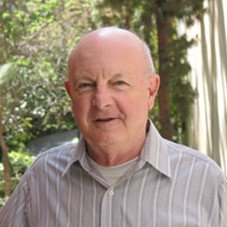Gerald Schubert (1939 - 2025)

Gerald 'Jerry' Schubert, Professor Emeritus at UCLA, passed away at the age of 86 on August 31, 2025, surrounded by his family and loved ones at his home in Woodland Hills, California. He was one of the fathers of modern geodynamics and planetary physics. Entering the geosciences in the 1960s — at the dawn of both space exploration and the plate tectonic revolution — he brought the tools of engineering physics to bear on a myriad of problems in geophysics, planetary physics, and astrophysics.
Jerry received his undergraduate and master’s degree from Cornell University in aeronautical engineering in 1961, where he first crossed paths with Don Turcotte, who was a new assistant professor assigned to Jerry's master’s thesis committee as he was finishing. Jerry went to fulfill his ROTC commitment to the Navy by serving in Admiral Hyman Rickover's Naval Nuclear Power School as an instructor until 1965. During that same time, he acquired (surreptitiously, as Jerry liked to say) a PhD in Engineering at UC Berkeley, which he received in 1964. After a stint at Bell Labs and a NAS/NRC postdoc at DAMTP in Cambridge, he joined the UCLA faculty in 1966 where he remained for the rest of his career. Over the years the department morphed and grew from “Geophysics and Space Physics” to “Earth and Space Sciences” to “Earth, Planetary and Space Sciences”. Jerry established himself as one of the pillars of the department with his far-reaching research program and was appointed department chair in 2000.
Jerry's research ranged over a remarkable number of topics from the Sun to the core and mantle of the terrestrial planets, to the atmospheres of Earth, Venus and the Giant outer solar system planets. He was involved in many NASA missions, starting on the Apollo 15 and 16 magnetometer teams, going through the Magellan and Galileo missions, and participating in analyzing data from the Juno mission. Despite covering so many fields, Jerry's scientific contributions were seminal, including understanding solar instabilities, lunar magnetism, the thermal evolution of the interiors of Earth and Venus, the role of phase changes in convection, the cause for Venus's retrograde 'super-rotating' atmospheric circulation, acoustic-gravity waves in the Earth's upper atmosphere, zonal winds on Jupiter, tidal heating in Io, and core dynamos, to name afew. As of 2003 (the last time his UCLA webpage was updated) he had 430 papers, and surely well over 500 (if not 600) by now.
Jerry had colleagues and collaborators from around the world, all of whom valued and benefitted from his deep physical insight, his pragmatic approach to science, and his precise and elegant writing. He authored with Don Turcotte (who passed away last February) the highly acclaimed and widely used textbook "Geodynamics" (which went through three editions). With Don and Peter Olson, he published the 2001 tome "Mantle Convection in the Earth and Planets". Jerry was the editor-in-chief for the Treatise on Geophysics through two editions (2007 and 2015). He was the editor for JGR in the mid-1980s before it exploded into multiple flavors, as well as of Icarus and PEPI. He served on many committees for the NRC, NASA and AGU. He was also largely responsible for resurrection of the Gordon Research Conference on “Earth’s Interior” in 1996 (23 years after the geophysicists were banished from the GRC, following an ‘energetic’ mid-GRC response to the resignation of Richard Nixon).
Jerry mentored many generations of PhD students, including myself, David Sandwell (UCSD), David Baker (CIRA, Colorado State University), and the late David Yuen (University of Minnesota); this of course led to the perennial joke that Jerry could only graduate PhD students named Dave (with apologies to both Dr. Seuss and Jerry’s many students not named Dave). Jerry was the recipient of numerous awards and honors, including a Guggenheim Fellowship in 1972, AGU Fellowship with the James B. Macelwane Medal in 1975, and election to the American Academy of Arts & Sciences in 2001. In 2002, he received both the Harry Hess Medal from AGU and was elected to the National Academy of Sciences.
On behalf of all his friends and colleagues and former students, I can say Jerry Schubert will be dearly missed. Our heart goes out to his family, including his wife Joyce, who Jerry took care of so lovingly for many years, and especially to his youngest daughter Tamara who took care of both her parents when Jerry fell ill last winter, and so thoughtfully communicated to Jerry's friends when he couldn't. I like to think that, after his long, full life, Jerry is with many of his old friends, arguing about subduction initiation, or zonal winds on Jupiter, or planetary dynamos. That would be his idea of heaven (that and a rough game of handball).
Dave Bercovici, Yale University
